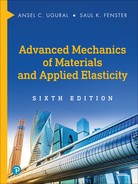Chapter 6. Torsion of Prismatic Bars
6.1 Introduction
In this chapter, consideration is give to stresses and deformations in prismatic members subject to equal and opposite end torques. In general, these bars arne assumed to be free of end constraint. Usually, members that transmit torque, such as propeller shafts and torque tubes of power equipment, are circular or tubular in cross section. For circular cylindrical bars, the torsion formulas are readily derived by employing the method of mechanics of materials, as illustrated in the next section. In Sec. 6.6.2, we will observe that a shaft having a circular cross section is most efficient compared to a shaft having an arbitrary cross section.
Slender members with other-than-circular cross sections are also often used. In treating noncircular prismatic bars, cross sections that are initially plane (Fig. 6.1a) experience out-of-plane deformation or warping (Fig. 6.1b), and the basic kinematic assumptions of the elementary theory are no longer appropriate. Consequently, the theory of elasticity, a general analytic approach, is employed, as discussed in Section 6.4. The governing differential equations derived using this method are applicable to both the linear elastic and the fully plastic torsion problems. The latter is treated in Section 12.10.

Figure 6.1. Rectangular bar: (a) before loading; (b) after a torque is applied.
For cases that cannot be conveniently solved analytically, the governing expressions are used in conjunction with the membrane and fluid flow analogies, as discussed in Sections 6.6 through 6.9. Computer-oriented numerical approaches (Chapter 7) are also very efficient for such situations. This chapter concludes with discussions of warping of thin-walled open cross sections and combined torsion and bending of curved bars.
6.2 Elementary Theory of Torsion of Circular Bars
Consider a torsion bar or shaft of circular cross section (Fig. 6.2). Assume that the right end twists relative to the left end so that longitudinal line AB deforms to AB′. This results in a shearing stress τ and an angle of twist or angular deformation ϕ. As an earlier study of mechanics of materials [Ref. 6.1] revealed, the following basic assumptions underlie the formulations for the torsional loading of circular bars:
All plane sections perpendicular to the longitudinal axis of the bar remain plane following the application of torque; that is, points in a given cross-sectional plane remain in that plane after twisting.
Subsequent to twisting, cross sections are undistorted in their individual planes; that is, the shearing strain γ varies linearly from zero at the center to a maximum on the outer surface.
The preceding assumptions hold for both elastic and inelastic material behavior. In the elastic case, the following condition also applies:
The material is homogeneous and obeys Hooke’s law; hence, the magnitude of the maximum shear angle γmax must be less than the yield angle.

Figure 6.2. Variation of stress and angular rotation of a circular member in torsion.
We now derive the elastic stress and deformation relationships for circular bars in torsion in a manner similar to the most fundamental equations of the mechanics of materials: by employing the previously considered procedures and the foregoing assumptions. In the case of these elementary formulas, there is complete agreement between the experimentally obtained and the computed quantities. Moreover, their validity can be demonstrated through application of the theory of elasticity (see Example 6.4).
6.2.1 Shearing Stress
On any bar cross section, the resultant of the stress distribution must be equal to the applied torque T (Fig. 6.2). That is,
T=∫ρ(τdA)=∫ρ(ρrτmax) dA
where the integration proceeds over the entire area of the cross section. At any given section, the maximum shearing stress τmax and the distance r from the center are constant. Hence, the preceding expression can be written
T=τmaxr∫ρ2dA(a)
where ∫ρ2dA = J is the polar moment of inertia of the circular cross section (Section C.2). For circle of radius r, J = π r4/2. Thus,
τmax=TrJ(6.1)
This is the well-known torsion formula for circular bars. The shearing stress at a distance ρ from the center is
τ=TρJ(6.2)
The transverse shearing stress obtained by Eq. (6.1) or (6.2) is accompanied by a longitudinal shearing stress of equal value, as shown on a surface element in Fig. 6.2.
When a shaft is subjected to torques at several points along its length, the internal torques will vary from section to section. A graph showing the variation of torque along the axis of the shaft is called the torque diagram. Such a diagram represents a plot of the internal torque T versus its position x along the shaft length. As a sign convention, T will be positive if its vector is in the direction of a positive coordinate axis. However, the torque diagram is rarely used, because in practice, only a few variations in torque occur along the length of a given shaft.
6.2.2 Angle of Twist
According to Hooke’s law, γmax = τmax/G; introducing the torsion formula, γmax = Tr/JG, where G is the modulus of elasticity in shear. For small deformations, tan γmax = γmax, and we may write γmax = rϕ/L (Fig. 6.2). These expressions lead to the angle of twist—that is, the angle through which one cross section of a circular bar rotates with respect to another:
ϕ=TLJG(6.3)
Angle ϕ is measured in radians. The product JG is termed the torsional rigidity of the member.
Note that Eqs. (6.1) through (6.3) are valid for both solid and hollow circular bars; this follows from the assumptions used in the derivations. For a circular tube of inner radius ri and outer radius r0, we have J=π(r40−r4i)/2.
Example 6.1 Stress and Deformation in an Aluminum Shaft
A hollow aluminum alloy 6061-T6 shaft of outer radius c = 40 mm, inner radius b = 30 mm, and length L = 1.2 m is fixed at one end and subjected to a torque T at the other end, as shown in Fig. 6.3. If the shearing stress is limited to τmax = 140 MPa, find (a) the largest value of the torque; (b) the corresponding minimum value of shear stress; and (c) the angle of twist that will create a shear stress τmin = 100 MPa on the inner surface.
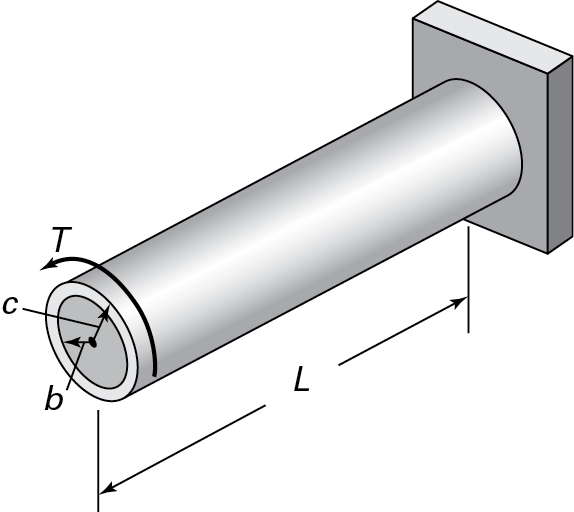
Figure 6.3. Example 6.1. A tubular circular bar in torsion.
Solution From Table D.1, we have the shear modulus of elasticity G = 72 GPa and τyp = 220 MPa.
In as much as τmax < τyp, we can apply Eq. (6.1) with r = c to obtain
T=Jτmaxc(b)
By Table C.1, the polar moment of inertia of the hollow circular tube is
J=π2(c4−b4)=π2(404−304)=2.749(106) mm4
Inserting J and τmax into Eq. (b) results in
T=2.749(10−6)(140×106)0.04=9.62 kN ⋅m
The smallest value of the shear stress is found on the inner surface of the shaft, and τmin and τmax are proportional to b and c, respectively. Therefore,
τmin=bcτmax=3040=105 MPa
Through the use of Eq. (2.27), the shear strain on the inner surface of the shaft is equal to
γmin=τminG=105×10672×109=1458 μ
Referring to Fig. 6.2,
ϕ=Lγminb=120030(1458×10−6)=58.3×10−3 rad
or
ϕ = 3.34°.
Example 6.2 Redundantly Supported Shaft
Given: A solid circular shaft AB fixed to rigid walls at both ends and subjected to a torque T at section C, as shown in Fig. 6.4a. The shaft diameters are da and db for segments AC and CB, respectively.

Figure 6.4. Example 6.2. (a) A fixed-ended circular shaft in torsion; (b) free-body diagram of the entire shaft.
Find: The lengths a and b if the maximum shearing stress in both shaft segments is to be the same for da = 20 mm and db = 12 mm and L = 600 mm.
Solution From the free-body diagram of Fig. 6.4a, we observe that the problem is statically indeterminate to the first degree; the one equation of equilibrium available is not sufficient to obtain the two unknown reactions TA and TB.
Condition of Equilibrium. Using the free-body diagram of Fig. 6.4b,
∑T=0,TA+TB=T(c)
Torque-Displacement Relations. The angle of twist at section C is expressed in terms of the left and right segments of the solid shaft, respectively, as
ϕa=TAaJaG, ϕb=TBbJbG(d)
Here, the polar moments of inertia are Ja=πd4a/32 and Jb=πd4b/32.
Condition of Compatibility. The two segments must have the same angle of twist where they join. Thus,
ϕa=ϕborTAaJaG=TBbJbG(e)
Equations (c) and (e) can be solved simultaneously to yield the reactions
TA=T1+(aJb/bJa), TB=T1+(bJa/aJb)(f)
The maximum shearing stresses in each segment of the shaft are obtained from the torsion formula:
τa=TAda2Ja, τb=TBdb2Jb(g)
For the case under consideration τa = τb, or
TAdaJa=TBdbJb
Introducing Eqs. (f) into this expression and simplifying, we obtain
ab=dadb
from which
a=daLda+db, b=dbLda+db(h)
where L = a + b. Inserting the given data results in
a=200(600)20+12=375 mm, b=12(600)20+12=225 mm
Comment For a prescribed value of torque T, we can now compute the reactions, angle of twist at section C, and maximum shearing stress from Eqs. (f), (d), and (g), respectively.
6.2.3 Axial and Transverse Shear Stresses
In the preceding discussion, we considered shear stresses acting in the plane of a cut perpendicular to the axis of the shaft, defined by Eqs. (6.1) and (6.2). Their directions coincide with the direction of the internal torque T on the cross section (Fig. 6.2). These stresses must be accompanied by equal shear stresses occurring on the axial planes of the shaft, since equal shear stresses always exist on mutually perpendicular planes.
Now consider the state of stress depicted in Fig. 6.5a. Note that τ is the only stress component acting on this element removed from the bar; the element is in the state of pure shear. Observe that τ = τxz = τzx denotes the shear stresses in the tangential and axial directions. So, the internal torque develops not only a transverse shear stress along radial lines or in the cross section, but also an associated axial shear stress distribution along a longitudinal plane. The variation of these stresses on the mutually perpendicular planes is illustrated in Fig. 6.5b, where a portion of the shaft has been removed for illustration purposes. Consequently, if a material is weaker in shear axially than laterally (such as wood), the failure in a twisted bar occurs longitudinally along axial planes.
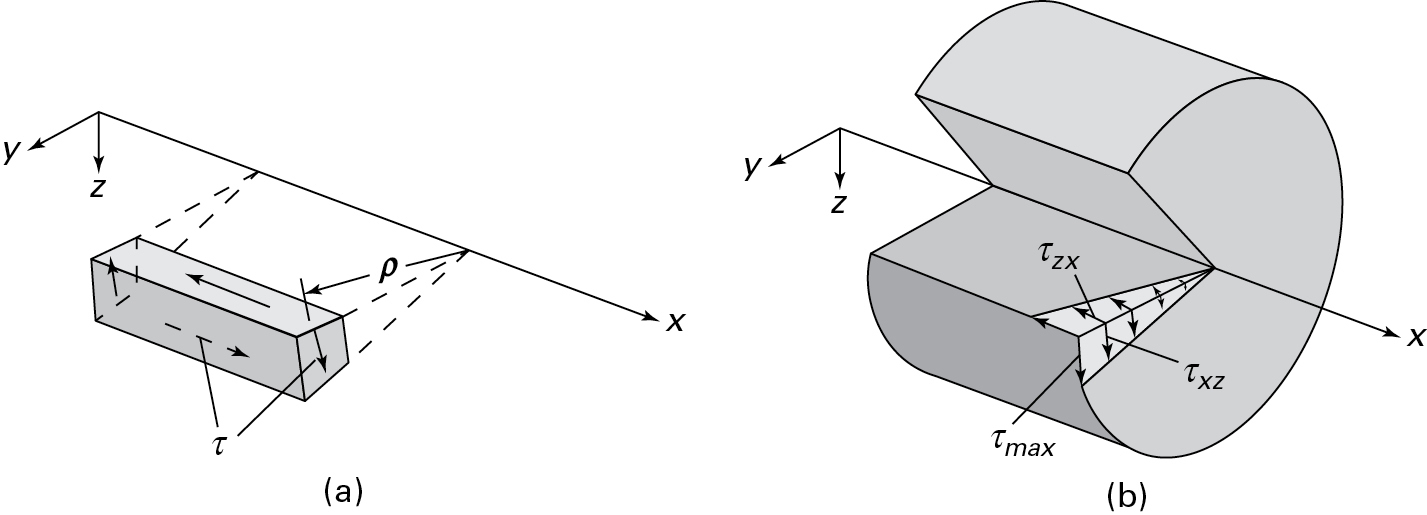
Figure 6.5. Shearing stresses on transverse (xz) and axial (zx) planes of a shaft (Fig. 6.2): (a) shaft element in pure shear; (b) shaft segment in pure shear
6.3 Stresses on Inclined Planes
Our treatment thus far has been limited to shearing stresses on planes at a point parallel or perpendicular to the axis of a shaft, defined by the torsion formula. This state of stress is depicted acting on a surface element on the left of the shaft in Fig. 6.6a. Alternatively, representation of the stresses at the same point may be given on an infinitesimal two-dimensional wedge whose outer normal (x′) on its oblique face makes an angle θ with the axial axis (x), as shown in Fig. 6.6b.

Figure 6.6. (a) Stresses acting on the surface elements of a shaft in torsion; (b) free-body diagram of wedge cut from the shaft; (c) Mohr’s circle for torsional loading.
6.3.1 Stress Transformation
In this section, we will analyze the stresses σx′ and τx′y′ that must act on the inclined plane to keep the isolated body, as discussed in Sections 1.7 and 1.9. The equilibrium conditions of forces in the x′ and y′ directions, given by Eqs. (1.18a) and (1.18b) with σx = σy = 0 and, τxy = -τmax yield
σx′=−τmaxsin 2θ(a)
τx′y′=−τmaxcos 2θ(b)
These are the equations of transformation for stress in a shaft under torsion.
Figure 6.6c, a Mohr’s circle for torsional loading, provides a convenient way of checking the preceding results. Observe that the center C of the circle is at the origin of the coordinates σ and τ. Now recall that points A′ and B′ define the states of stress about any other set of x′ and y′ planes relative to the set through an angle. Similarly, the points and A(0, τmax) and B(0, τmin) are located on the τ axis, while A1 and B1 define the principal planes and the principal stresses. The radius of the circle is equal to the magnitude of the maximum shearing stress.
The variation in the stresses σx′ and σx′y′, given by Eqs. (a) and (b), with the orientation of the inclined plane is demonstrated in Fig. 6.7. Notice that τmax = τ and τx′y′ = 0 when θ = 45° and σmin = -τ and τx′y′ = 0 when θ = 135°. That is, the maximum normal stress equals σ1 = Tr/J and the minimum normal stress equals σ2 = Tr/J, acting in the directions shown in Fig. 6.6a. Also, no shearing stress greater than τ is developed.
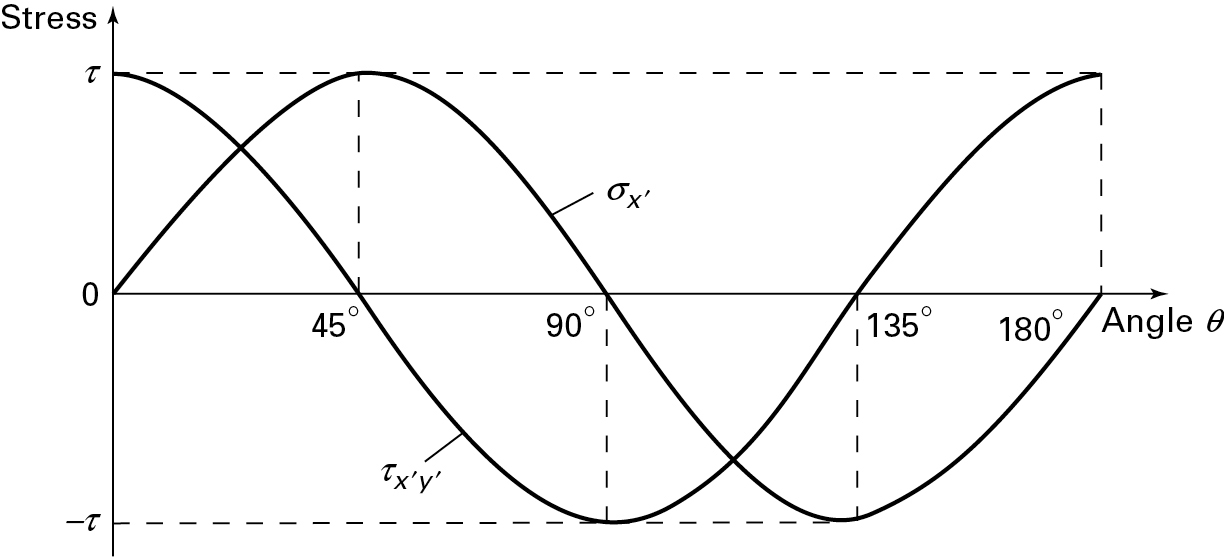
Figure 6.7. Graph of normal stress σx′ and shear stress τx′y′ versus angle θ of the inclined plane.
For a brittle material such as cast iron, which is weaker in tension than in shear, failure occurs in tension along a helix as indicated by the dashed lines in Fig. 6.6a. Ordinary chalk behaves in the same manner. Conversely, shafts made of ductile materials that are weak in shearing strength (for example, mild steel) break along a line perpendicular to the axis. This behavior is consistent with the types of tensile failures discussed in Section 2.7.
6.3.2 Transmission of Power by Shafts
The power in kilowatts (kW) transmitted by a rotating shaft is of keen interest in the study of machines. As found from first principles,
T=9549 kWn (6.4a)
Here T = torque (N · m) and n = shaft speed (rpm). Since 1 horsepower (hp) equals 0.7457 kW, the preceding equation may be written as
hp=FV745.7=Tn7121(6.4b)
where F is the tangential force (N) and V represents the velocity (m/s). More will be said about rotating shafts, disks, and flywheels in Chapter. 8.
In the design of circular slender shafts that transmit power at a specified speed, the material and the dimensions of the cross section are selected to not exceed the permissible shearing stress or a limiting angle of twist when rotating. A designer thus needs to know the torque acting on the power-transmitting shaft. Equations (6.4) may be used to convert the power supplied to the shaft into a constant torque exerted on it during rotation. After having determined the torque to be transmitted, the design of circular shafts to meet strength requirements can be accomplished by using the process outlined in Section 1.3.1.
Example 6.3 Design of a Shaft
A solid circular shaft of radius r is to transmit 400 kW at n = 1000 rpm without exceeding the yield strength in shear of τys or a twisting through more than 5° in a length of 2 m.
Find: The required diameter of the shaft.
Given: The shaft is made of steel having τys = 310 MPa and G = 80 GPa. A safety factor of 1.6 is used.
Solution Using Eq. (6.4a), we find the torque:
T=9549(400)1000=3820 N⋅m
Strength Specification. Equation (6.1) with a factor of safety of 1.6 leads to
π2r3=3820(1.6)310(106)
Solving, r = 23.2 mm.
Distortion Specification. We now determine the size of the shaft by applying Eq. (6.3):
ΦallL=TGJ(c)
Inserting the given numerical values,
5°(π/180)2=3820(80×109)πr4/2
This results in r = 28.9 mm.
Comment The minimum allowable diameter of the shaft must be 57.8 mm. Thus, a 58-mm shaft diameter should be used.
6.4 General Solution of the Torsion Problem
Consider a prismatic bar of constant arbitrary cross section subjected to equal and opposite twisting moments applied at the ends, as shown in Fig. 6.8a. The origin of x, y, and z in the figure is located at the center of twist of the cross section, about which the cross section rotates during twisting. The center of twist is also sometimes defined as the point at rest in every cross section of a bar in which one end is fixed and the other twisted by a couple. At this point, u and the x and y displacements are all zero.

Figure 6.8. Torsion member of arbitrary cross section.
The location of the center of twist is a function of the shape of the cross section. Note that while the center of twist is referred to in the derivations of the basic relationships, it is not dealt with explicitly in the solution of torsion problems (see Prob. 6.25). The z axis passes through the centers of twist of all cross sections.
6.4.1 Geometry of Deformation
In general, the cross sections warp, as already noted. We now explore the problem of torsion with free warping, by applying the Saint-Venant semi-inverse method [Refs. 6.2 and 6.3]. As a fundamental assumption, the warping deformation is taken to be independent of axial location; that is, it is identical for any cross section:
w=f(x,y)(a)
It is also assumed that the projection on the xy plane of any warped cross section rotates as a rigid body and that the angle of twist per unit length of the bar, θ, is constant.
We refer now to Fig. 6.8b, which shows the partial end view of the bar (and could represent any section). An arbitrary point on the cross section, point P(x, y), located a distance r from center of twist A, has moved to P′(x − u, y + υ) as a result of torsion. Assuming that no rotation occurs at end z = 0 and that θ is small, the x and y displacements of P are, respectively,
u=−(rθz)sinα=−yθzυ=(rθz)cosα=xθz(b)
Here the angular displacement of AP at a distance z from the left end is θz; then x, y, and z are the coordinates of point P, and α is the angle between AP and the x axis. Clearly, Eqs. (b) specify the rigid body rotation of any cross section through a small angle θz. By substituting Eqs. (a) and (b) into Eq. (2.4), we have
εx=γxy=εy=εz=0γzx=∂w∂x−yθ,γzy=∂w∂y+xθ(c)
Combining Equation (2.36) with these expressions leads to the following:
σx=σy=σz=τxy=0(d)
τzx=G(∂w∂x−yθ)τzy=G(∂w∂y+xθ)(e)
6.4.2 Equations of Equilibrium
By now substituting Eq. (d) into the equations of equilibrium (1.14), and assuming negligible body forces, we obtain
∂τzx∂z=0,∂τzy∂z=0,∂τzx∂x+∂τzy∂y=0(6.5)
6.4.3 Equations of Compatibility
Differentiating the first equation of Eqs. (e) with respect to y and the second equation with respect to x, and subtracting the second from the first, we obtain an equation of compatibility:
∂τzx∂y−∂τzy∂x=H(6.6)
where
H=−2Gθ(6.7)
Thus, the stress in a bar of arbitrary section may be determined by solving Eqs. (6.5) and (6.6) along with the given boundary conditions.
6.5 Prandtl’s Stress Function
As in the case of beams, the torsion problem is commonly solved by introducing a single stress function. If a function Φ(x, y) known as the Prandtl stress function, is assumed to exist, such that
τzx=∂Φ∂y, τzy=−∂Φ∂x(6.8)
then the equations of equilibrium (6.5) are satisfied. The equation of compatibility (6.6) becomes, upon substitution of Eq. (6.8),
∂2Φ∂x2+∂2Φ∂y2=H(6.9)
The stress function Φ must therefore satisfy Poisson’s equation if the compatibility requirement is to be satisfied.
6.5.1 Boundary Conditions
We are now prepared to consider the boundary conditions, treating first the load-free lateral surface. Recall from Section 1.5 that τxz is a z-directed shearing stress acting on a plane whose normal is parallel to the x axis—that is, the yz plane. Similarly, τzx acts on the xy plane and is x-directed. By virtue of the symmetry of the stress tensor, we have τxz = τzx and τyz = τzy. Therefore, the stresses given by Eq. (e) may be indicated on the xy plane near the boundary, as shown in Fig. 6.9. The boundary element is associated with arc length ds. Note that ds increases in the counterclockwise direction. When ds is zero, the element represents a point at the boundary. Then, referring to Fig. 6.9 together with Eq. (1.48), which relates the surface forces to the internal stress, and noting that the cosine of the angle between z and a unit normal n to the surface is zero [that is, cos(n, z) = 0], we have
τzxl+τzym=0(a)

Figure 6.9. Arbitrary cross section of a prismatic member in torsion.
According to Eq. (a), the resultant shear stress τ must be tangent to the boundary (Fig. 6.9). From the figure, it is clear that
l=cos(n, x)=dyds,m=cos(n, y)=−dxds(b)
As we proceed in the direction of increasing s, x decreases and y increases. This accounts for the algebraic sign in front of dx and dy in Fig. 6.9. Substituting Eqs. (6.8) and (b) into Eq. (a) yields
∂Φ∂ydyds+∂Φ∂xdxds=dΦds=0(on the boundary)(6.10)
This expression states that the directional deviation along a boundary curve is zero. Thus, the function Φ(x, y) must be an arbitrary constant on the lateral surface of the prism. Examination of Eq. (6.8) indicates that the stresses remain the same regardless of additive constants; that is, if Φ + constant is substituted for Φ, the stresses will not change. For solid cross sections, we are therefore free to set Φ equal to zero at the boundary.
In the case of multiply connected cross sections, such as hollow or tubular members, an arbitrary value may be assigned at the boundary of only one of the contours s0, s1,...., sn. For such members, however, we must extend the mathematical formulation presented in this section. In Section 6.8, we consider solutions for thin-walled, multiply connected cross sections by applying the membrane analogy.
Returning to the member of solid cross section, we finish our discussion of the boundary conditions by considering the ends, at which the normals are parallel to the z axis and therefore cos(n, z) = n = ±1, l = m = 0. Equation (1.48) now gives, for pz = 0,
px=±τzx,py=±τzy(c)
where the algebraic sign depends on the relationship between the outer normal and the positive z direction. For example, it is negative for the end face at the origin in Fig. 6.8a.
6.5.2 Force and Torque over the Ends
We now confirm that the summation of forces over the ends of the bar is zero:
∬px dx dy=∬τzx dx dy=∬∂Φ∂ydx dy =∫dxy2∫y1∂Φ∂y dy=∫Φ|y2y1dx= ∫(Φ2−Φ1) dx=0
Here y1 and y2 represent the y coordinates of points located on the surface. Because Φ = constant on the surface of the bar, the values of Φ corresponding to y1 and y2 must be equal to a constant, Φ1 = Φ2 = constant. Similarly, it may be shown that
∬τzy dx dy=0
The end forces, while adding to zero, must nevertheless provide the required twisting moment or externally applied torque about the z axis:
T=∬(xτzy−yτzx)dx dy=−∬x∂Φ∂x dx dy−∬y∂Φ∂ydx dy =−∫dy∫x∂Φ∂xdx−∫dx∫y∂Φ∂ydy
Integrating by parts, we have
T=−∫xΦx2x1dy+∬Φ dx dy−∫yΦy2y1dx+∬Φ dx dy
Since Φ = constant at the boundary and x1, x2, y1, and y2, denote points on the lateral surface, it follows that
T=2∬Φ dx dy(6.11)
As Φ(x, y) has a value at each point on the cross section, it is clear that Eq. (6.11) represents twice the volume beneath the Φ surface.
The result of applying this approach is a set of equations satisfying all the conditions of the prescribed torsion problem. Equilibrium is governed by Eqs. (6.8), compatibility by Eq. (6.9), and the boundary condition by Eq. (6.10). Torque is related to stress by Eq. (6.11). To ascertain the distribution of stress, it is necessary to determine a stress function that satisfies Eqs. (6.9) and (6.10), as is demonstrated in the following example.
Example 6.4 Analysis of an Elliptical Torsion Bar
Consider a solid bar of elliptical cross section (Fig. 6.10a). Determine the maximum shearing stress and the angle of twist per unit length. Also, derive an expression for the warping w(x, y).
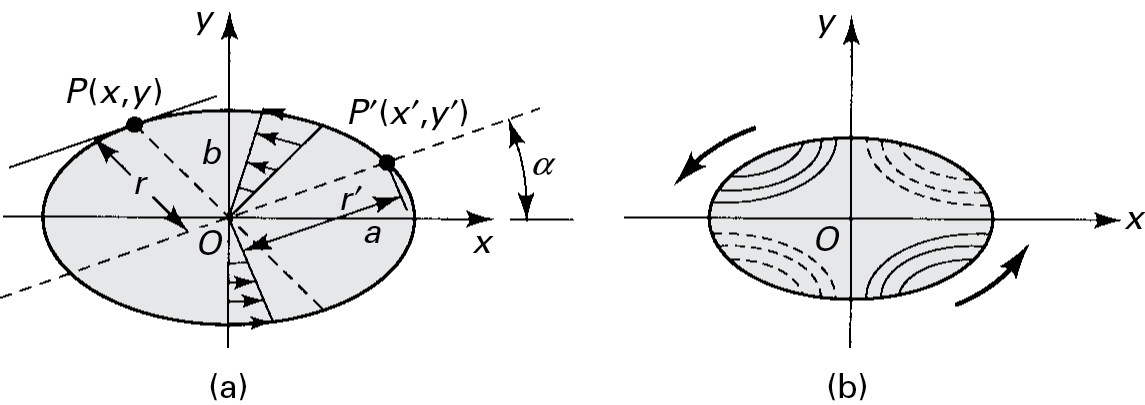
Figure 6.10. Example 6.4. Elliptical cross section: (a) shear stress distribution; (b) out-of-plane deformation or warping.
Solution Equations (6.9) and (6.10) are satisfied by selecting the stress function
Φ=k(x2a2+y2b2−1)
where k is a constant. Substituting this expression into Eq. (6.9), we obtain
k=a2b22(a2+b2)H
Hence,
Φ=a2b2H2(a2+b2)(x2a2+y2b2−1)(d)
and Eq. (6.11) yields
T=a2b2Ha2+b2(1a2∬x2 dx dy+1b2∬y2 dx dy−∬dx dy) =a2b2Ha2+b2(1a2Iy+1b2Ix−A)
Here A is the cross-sectional area. Inserting the expressions for Ix, Iy and A (Table C.1) results in
T=a2b2Ha2+b2(1a2πba34+1b2πab34−πab)=−πa3b3H2(a2+b2)(e)
from which
H=−2T(a2+b2)πa3b3(f)
The stress function is now expressed as
Φ=−Tπab(x2a2+y2b2−1)
and the shearing stresses are found readily from Eq. (6.8):
τzx=∂Φ∂y=−2Tyπab3=−Ty2Ixτzy=−∂Φ∂x=2Txπa3b=Tx2Iy(g)
The ratio of these stress components is proportional to y/x and, therefore, constant along any radius of the ellipse:
τzxτzy=−yxa2b2=−yxIyIx
The resultant shearing stress,
τzα=(τ2zx+τ2zy)1/2=2Tπab(x2a4+y2b4)1/2(h)
has a direction parallel to a tangent drawn at the boundary at its point of intersection with the radius containing the point under consideration. Note that α represents an arbitrary angle (Fig. 6.10a).
To determine the location of the maximum resultant shear, which from Eq. (g) is somewhere on the boundary, consider a point P′(x′, y′) located on a diameter conjugate to that containing P(x, y) (Fig. 6.10a). Note that OP′ is parallel to the tangent line at P. The coordinates of P and P′ are related by
x=aby′, y=bax′
Substituting these expressions into Eq. (h), we have
τzα=2Tπa2b2(x′2+y′2)1/2=2Tπa2b2r′(i)
Clearly, τzα will have its maximum value corresponding to the largest value of the conjugate semidiameter r′. This occurs where r′ = a or r = b. The maximum resultant shearing stress thus occurs at P(x, y), corresponding to the extremities of the minor axis as follows: x = 0, y = ±b. From Eq. (i),
τmax=2Tπab2(6.12a)
The angle of twist per unit length is obtained by substituting Eq. (f) into Eq. (6.7):
θ=(a2+b2)Tπa3b3G(6.12b)
The factor by which the twisting moment is divided to determine the twist per unit length is called the torsional rigidity, commonly denoted C. It is equal to
C=Tθ(6.13)
The torsional rigidity for an elliptical cross section, from Eq. (6.12b), is thus
C=πa3b3a2+b2 G=G4π2(A)4J
where A = πab and J = πab(a2+b2)/4 are the area and polar moment of inertia of the cross section, respectively.
The components of displacement u and υ are then found from Eq. (b) of Section 6.4. To obtain the warpage w(x, y), consider Eq. (e) of Section 6.4, in which the previously derived relations for τzx, τzy and θ are substituted:
τzx=−2Tyπab3=G[∂w∂x−y(a2+b2)Tπa3b3G]τzy=2Txπa3b=G[∂w∂y+x(a2+b2)Tπa3b3G]
Integration of these equations leads to identical expressions for w(x, y), except that the first also yields an arbitrary function of y, f (y), and the second an arbitrary function of x, f (x). Since w(x, y) must give the same value for a given P(x, y), we conclude that f (x) = f (y) = 0; what remains is
w(x,y)=TG(b2−a2)xyπa3b3(6.14)
Comment The contour lines, obtained by setting w = constant, are the hyperbolas shown in Fig. 6.10b. The solid lines indicate the portions of the section that become convex, and the dashed lines indicate the portions of the section that become concave when the bar is subjected to a torque in the direction shown.
6.5.3 Circular Cross Section
The results obtained in this example for an elliptical section may readily be reduced to the case of a circular section by setting a and b equal to the radius of a circle r (Fig. 6.6a). Equations (6.12a and b) thus become
τmax=2Tπr3=TrJ,ϕ=θL=TLJG
where J = πr4/2 is the polar moment of inertia. Similarly, Eq. (6.14) gives w = 0, verifying assumption (1) of Section 6.2.
Example 6.5 Equilateral Triangle Bar Under Torsion
An equilateral cross-sectional solid bar is subjected to pure torsion (Fig. 6.11). What are the maximum shearing stress and the angle of twist per unit length?
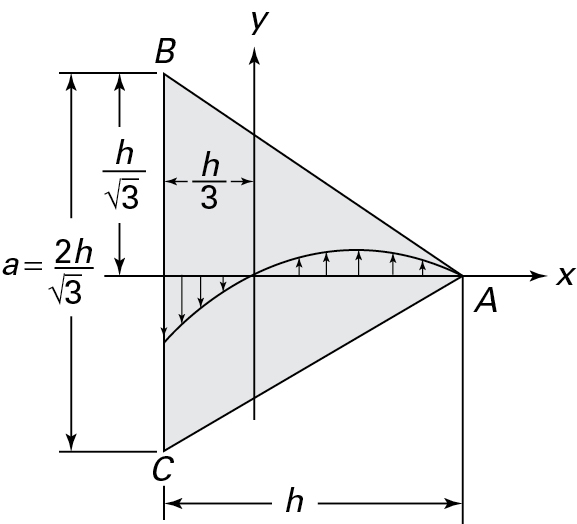
Figure 6.11. Example 6.5. Equilateral triangle cross section.
Solution The equations of the boundaries are expressed as
x+h3=0on BC x√3+y−2h3√3=0on AB
x√3−y−2h3√3=0on AC
Therefore, the stress function that vanishes at the boundary may be written in the form
Φ=k(x+√3 y−2h3)(x−√3y−2h3)(x+h3)(j)
in which k is constant.
Proceeding as in Example 6.4, we can readily see (see Prob. 6.29) that the largest shearing stress at the middle of the sides of the triangle is equal to
τmax=15√3T2h3(k)
At the corners of the triangle, the shearing stress is zero, as shown in Fig. 6.11. The angle of twist per unit length is given by
θ=15√3Th4G(I)
The torsional rigidity is therefore C=T/θ=h4G/15√3. Note that, for an equilateral triangle of sides a, we have a=2h/√3 (Fig. 6.11).
Example 6.6 Rectangular Bar Subjected to Torsion
A torque T acts on a bar having rectangular cross section of sides a and b (Fig. 6.12). Outline the derivations of the expressions for the maximum shearing stress τmax and the angle of twist per unit length θ.
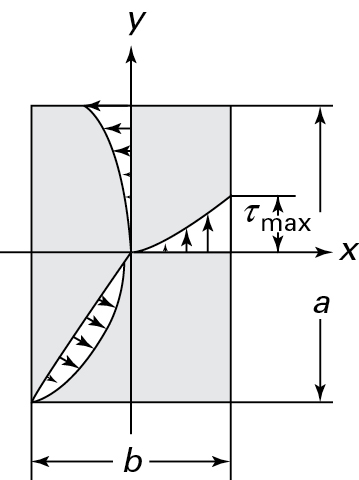
Figure 6.12. Example 6.6. Shear stress distribution in the rectangular cross section of a torsion bar.
Solution The indirect method employed in the preceding examples does not apply to the rectangular cross sections, and mathematical solution of the problem is a lengthy process. For situations that cannot be conveniently solved by applying the theory of elasticity, the governing equations are used in conjunction with the experimental methods, such as membrane analogy [Ref. 6.4]. Finite element analysis is also very efficient for this purpose.
The shear stress distribution along three radial lines initiating from the center of a rectangular section of a bar in torsion is shown in Fig. 6.12, where the largest stresses occur along the center line of each face. The difference in this stress distribution compared with that of a circular section is very clear. For the latter, the stress reaches a maximum at the most remote point, but for the former, the stress is zero at the most remote point. The values of the maximum shearing stress τmax in a rectangular cross section and the angle of twist per unit length θ are given in the next section (see Table 6.2 later in that section).
Comments Interestingly, a corner element of the cross section of a rectangular shaft under torsion does not distort at all, so that the shear stresses are zero at the corners, as illustrated in Fig. 6.13. This is possible because outside surfaces are free of all stresses. The same considerations can be applied to the other points on the boundary. The shear stresses acting on three outermost cubic elements isolated from the bar are illustrated in the figure, with the stress-free surfaces being shaded. Observe that all shear stressesτxy and τxz in the plane of a cut near the boundaries act on them.

Figure 6.13. Example 6.6. Deformation and stress in a rectangular bar segment under torsion. Note that the original plane cross sections have warped out of their own plane.
6.6 Prandtl’s Membrane Analogy
In this section, we demonstrate that the differential equation for the stress function, Eq. (6.9), has the same form as the equation describing the deflection of a membrane or soap film subject to pressure. Hence, an analogy exists between the torsion and membrane problems, which serves as the basis for a number of experimental techniques. Consider an edge-supported homogeneous membrane, whose its boundary contour is defined by a hole cut in a plate (Fig. 6.14a). The shape of the hole is the same as that of the twisted bar to be studied; the sizes need not be identical.

Figure 6.14. Membrane analogy for torsion members of solid cross section.
6.6.1 Equation of Equilibrium
The equation describing the z deflection of the membrane is derived from considerations of equilibrium applied to the isolated element abcd. Let the tensile forces per unit membrane length be denoted by S. From a small z deflection, the inclination of S acting on side ab may be expressed as β ≈ ∂z/∂x. Since z varies from point to point, the angle at which S is inclined on side dc is
β+∂β∂xdx≈∂z∂x+∂2z∂x2dx
Similarly, on sides ad and bc, the angles of inclination for the tensile forces are ∂z/∂y and ∂z/∂y + (∂2z/∂y2)dy, respectively.
In the development that follows, S is regarded as a constant, and the weight of the membrane is ignored. For a uniform lateral pressure p, the equation of vertical equilibrium is then
−(S dy)∂z∂x+S dy(∂z∂x+∂2z∂x2 dx)−(S dx)∂z∂y+(S dx)(∂z∂y+∂2z∂y2 dy)+p dx dy=0
leading to
∂2z∂x2+∂2z∂y2=−pS(6.15)
This is again Poisson’s equation. Comparing Eq. (6.15) with Eqs. (6.9) and (6.8), we see that the quantities shown in Table 6.1 are analogous. The membrane, subject to the conditions outlined, then represents the Φ surface (Fig. 6.14b). In view of the derivation, the restriction with regard to smallness of slope must be borne in mind.
Table 6.1. Analogy between Membrane and Torsion Problems
Membrane Problem |
Torsion Problem |
|---|---|
z |
Φ |
1S |
G |
p |
2θ |
−∂z∂x,∂z∂y |
τzy, τzx |
2 · (volume beneath membrane) |
T |
6.6.2 Shearing Stress and Angle of Twist
Next, we outline one method by which the foregoing theory can be reduced to a useful experiment. In two thin, stiff plates, bolted together, are cut two adjacent holes; one hole conforms to the outline of the irregular cross section and the other is circular. The plates are then separated and a thin sheet of rubber stretched across the holes (with approximately uniform and equal tension). Finally, the assembly is bolted together.
Subjecting one side of the membrane to a uniform pressure p causes a different distribution of deformation for each cross section, with the circular hole providing calibration data. The measured geometric quantities associated with the circular hole, together with the known solution, provide the needed proportionalities between pressure and angle of twist, slope and stress, volume and torque. These are then applied to the irregular cross section, for which the measured slopes and volume yield τ and T. This approach obviates the need for precise information concerning the membrane stress.
The membrane analogy provides more than a useful experimental technique. As is demonstrated in the next section, it also serves as the basis for obtaining approximate analytical solutions for bars of narrow cross section as well as for members of open thin-walled section.
For reference purposes, Table 6.2 presents the shearing stress and angle of twist for a number of commonly encountered shapes [Ref. 6.4]. Note that the values of coefficients α and β depend on the ratio of the length of the long side or depth a to the width b of the short side of a rectangular section. For thin sections, where a is much greater than b, their values approach 1/3. In all cases, the maximum shearing stresses occur at a point on the edge of the cross section that is closest to the center axis of the shaft. A circular shaft is the most efficient; it is subjected to both smaller maximum shear stress and a smaller angle of twist than the corresponding noncircular shaft of the same cross-sectional area and carrying the same torque.
Table 6.2. Shear Stress and Angle of Twist of Various Members in Torsion

Example 6.7 Analysis of a Stepped Bar in Torsion
A rectangular bar of width b consists of two segments: one with depth a1 = 60 mm and length L1 = 2.5 m, and the other with depth a2 = 45 mm and length L2 = 1.5 m (Fig. 6.15). The bar is to be designed using an allowable shearing stress τall = 50 MPa and an allowable angle of twist per unit length θall = 1.5° per meter.

Figure 6.15. Example 6.7. A stepped rectangular torsion bar.
Find: (a) The maximum permissible applied torque Tmax assuming b = 30 mm and G = 80 GPa; (b) the corresponding angle of twist between the end sections, ϕmax.
Solution The values of the torsion parameters from Table 6.2 are
For segment AC(a1b=2):α1=0.246andβ1=0.229For segment CB(a2b=1.5):α2=0.231andβ2=0.196
Segment BC governs the torque because it is of smaller depth. The permissible torque T based on the allowable shearing stress is obtained from τmax = T/α ab2 Thus,
T=α2a2b2τmax=0.231(0.045)(0.03)2(50×106)=468 N⋅m
The allowable torque T corresponding to the allowable angle of twist per unit length is determined from θ = T/βab3G:
T=β2a2b3Gθall=0.196(0.045)(0.03)3(80×109)(1.5π180)=499 N⋅m
The maximum permissible torque, equal to the smaller of the two preceding values, is Tmax = 468 N · m.
The angle of twist is equal to the sum of the angles of twist for the two segments:
ϕmax=Tmaxb3G(L1β1a1+L2β2a2) =468(0.033)(80×109)[2.50.229(0.06)+1.50.196(0.045)] =0.0763 rad=4.37°
Comment Clearly, had the allowable torque been based on the angle of twist per unit length, we would have found that ϕmax = θall(L1 + L2) = 1.5(4) = 6°.
6.7 Torsion of Narrow Rectangular Cross Section
In applying the analogy to a bar of narrow rectangular cross section, it is usual to assume a constant cylindrical membrane shape over the entire dimension b (Fig. 6.16). Subject to this approximation, ∂z/∂y = 0, and Eq. (6.15) reduces to d2z/dx2 = −p/S, which is twice integrated to yield the parabolic deflection
z=12pS[(t2)2−x2](a)
To arrive at Eq. (a), the boundary conditions that dz/dx = 0 at x = 0 and that z = 0 at x = t/2 have been employed. The volume bounded by the parabolic cylindrical membrane and the xy plane is given by V = pbt3/12S.
According to the analogy, p is replaced by 2θ and 1/S by G, and consequently T=2V=13bt3Gθ. The torsional rigidity for a thin rectangular section is therefore
C=Tθ=13bt3G=JeG(6.16)
where Je represents the effective polar moment of inertia of the section. The analogy also requires that
τzy=−∂z∂x=2Gθx(b)
The angle of twist per unit length is, from Eq. (6.16),
θ=3Tbt3G(6.17)
Maximum shear, which occurs at ± t/2, is
τmax=Gθt=3Tbt2(6.18)
or
T=13bt2τmax(6.19)
Equation (b) shows that, the shearing stress is linear in x, as in Fig. 6.9, producing a twisting moment T about z given by
T=2(12τmaxt2)(t3)(b)=16bt2τmax
This is exactly one-half the torque given by Eq. (6.19). The remaining applied torque is evidently resisted by the shearing stresses τzx, which was neglected in the original analysis in which the membrane is taken as cylindrical. The membrane slope at y = ±b/2 is smaller than that at x = ±t/2 or, equivalently, (τzx)max < (τzy)max. It is clear, therefore, that Eq. (6.18) represents the maximum shearing stress in the bar, of a magnitude unaffected by the original approximation. The fact that the lower τzx stresses can provide a resisting torque equal to that of the τzy stresses is explained on the basis of the longer moment arm for the stresses near y = ±bl2.
6.7.1 Thin-Walled Open Cross Sections
Equations (6.17) and (6.18) are also applicable to thin-walled open sections such as those shown in Fig. 6.17. Because the previously given expressions neglect stress concentration, the points of interest should be reasonably distant from the corners of the section (Figs. 6.17b and c). The validity of the foregoing approach depends on the degree of similarity between the membrane shape of Fig. 6.16 and that of the geometry of the component section.

Figure 6.16. Membrane analogy for a torsional member of narrow rectangular cross section: (a) contours; (b) side view of membrane.
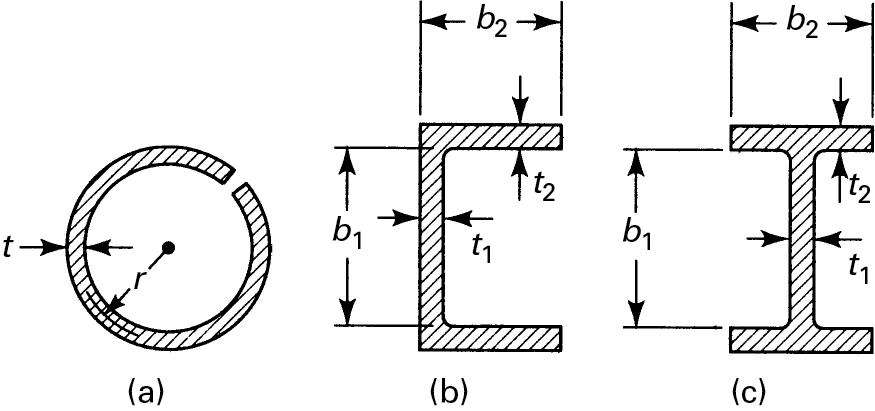
Figure 6.17. Thin-walled open sections.
Consider, for example, the I-section of Fig. 6.17c. Because the section is of varying thickness, the effective polar moment of inertia is written as
Je=∑13 bt3(6.20)
or
Je=13b1t31+23b2t32
We thus have
θ=TJeG=3TG1b1t31+2b2t32(6.21a)
τmax=Gθti=3Ttib1t31+2b2t32(6.21b)
where ti is the larger of t1 and t2. The effect of the stress concentrations at the corners is examined in Section 6.9.
6.8 Torsion of Multiply Connected Thin-Walled Sections
The membrane analogy may be applied to good advantage to analyze the torsion of thin tubular members, provided that some care is taken. Consider the deformation that would occur if a membrane subject to pressure were to span a hollow tube of arbitrary section (Fig. 6.18a). Since the membrane surface is to describe the stress function (and its slope, the stress at any point), arc ab cannot represent a meaningful stress function.

Figure 6.18. Membrane analogy for tubular torsion members: (a) and (b) one-cell section; (c) two-cell section.
In the region ab, the stress must be zero, because no material exists there. If the curved surface ab is now replaced by a plane representing constant Φ, the zero-stress requirement is satisfied. For bars containing multiply connected regions, each boundary is also a line of constant Φ of different value. The absolute value of Φ is meaningless. Thus, at one boundary, Φ may arbitrarily be equated to zero and the others adjusted accordingly.
6.8.1 Shearing Stress
Based on the previous discussion, the membrane analogy may be extended to a thin tubular member (Fig. 6.18b), in which the fixed plate to which the membrane is attached has the same contour as the outer boundary of the tube. The membrane is also attached to a “weightless” horizontal plate having the same shape as the inner boundary nn of the tube, thereby bridging the inner and outer contours over a distance t.
The inner horizontal plate, made “weightless” by a counterbalance system, is permitted to seek its own vertical position but is guided so as not to experience sideward motion. Because we have assumed the tube to be thin walled, the membrane curvature may be disregarded; that is, lines nn may be considered straight. We are thus led to conclude that the slope is constant over a given thickness t, and consequently the shearing stress is likewise constant; it is given by
τ=ht or h=τt(a)
where h is the membrane deflection and t the tube thickness. Note that the tube thickness may vary circumferentially.
The dashed line in Fig. 6.18b indicates the mean perimeter, which may be used to determine the volume bounded by the membrane. Letting A represent the area enclosed by the mean perimeter, the volume mnnm is simply Ah, and the analogy gives
T=2Ah or h=T2A(b)
Combining Eqs. (a) and (b), we have
τ=T2At(6.22)
The application of Eq. (6.22) is limited to thin-walled members displaying no abrupt variations in thickness and no reentrant corners in their cross sections.
6.8.2 Angle of Twist
To develop a relationship for the angle of twist from the membrane analogy, we again consider Fig. 6.18b, in which h ≪ t and consequently tan(h/t) ≈ h/t = τ. Vertical equilibrium therefore yields
pA=∮(htS) ds=∮τS ds
in which s is the length of the mean perimeter of the tube. Since the membrane tension is constant, h is independent of S. The preceding expression can therefore be written as
pS=1A∮τ ds=hA∮dst=2Gθ
where the last term follows from the analogy. The angle of twist per unit length is now found directly:
θ=h2AG∮dst=12AG∮τ ds(6.23)
Equations (6.22) and (6.23) are known as Bredt’s formulas.
In Eqs. (a), (b), and (6.23), the quantity h possesses the dimensions of force per unit length, representing the resisting force per unit length along the tube perimeter. For this reason, h is referred to as the shear flow.
Example 6.8 Rectangular Torsion Tube
An aluminum tube of rectangular cross section (Fig. 6.19a) is subjected to a torque of 56.5 KN · m along its longitudinal axis. Determine the shearing stresses and the angle of twist. Assume G = 28 GPa.
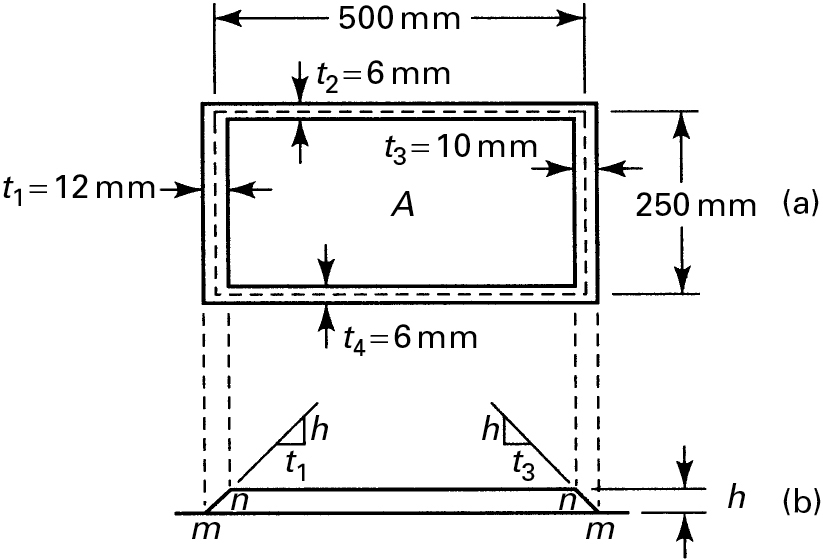
Figure 6.19. Example 6.8. (a) Cross section; (b) membrane.
Solution Referring to Fig. 6.19b, which shows the membrane surface mnnm (representing Φ), the applied torque is, according to Eq. (b),
T=2Ah=2(0.125h)=56,500 N⋅m
from which h = 226,000 N/m. The shearing stresses are found from Eq. (a) as follows:
τ1=ht1=226,0000.012=18.83 MPaτ2=ht2=ht4=226,0000.006=37.67 MPaτ3=ht3=226,0000.01=22.6 MPa
Applying Eq. (6.23), the angle of twist per unit length is
θ=h2AG∮dst=226,0002×28×109×0.125(0.250.012+20.50.006+0.250.01) =0.00686 rad/m
If multiply connected regions exist within a tubular member, as in Fig. 6.18c, the previously described techniques are again appropriate. As before, the thicknesses are assumed small, so lines such as mn, np, and pm are regarded as straight. The stress function is then represented by the membrane surface mnnppm. As in the case of a simple hollow tube, lines nn and pp are straight by virtue of flat, weightless plates with contours corresponding to the inner openings. Referring to the figure, the shearing stresses are
τ1=h1t1, τ2=h2t2 (c)
τ3=h1−h2t3=t1τ1−t2τ2t3(d)
The stresses are produced by a torque equal to twice the volume beneath surface mnnppm,
T=2A1h1+2A2h2(e)
or, after substituting Eqs. (c),
T=2A1t1τ1+2A2t2τ2(f)
Assuming the thicknesses t1, t2, and t3 remain constant, application of Eq. (6.23) yields
τ1s1+τ3s3=2GθA1(g)
τ2s2−τ3s3=2GθA2(h)
where s1, s2, and s3 represent the paths of integration indicated by the dashed wof stress, and the direction in which integration proceeds. Thus, there are four equations [(d), (f), (g), and (h)] containing four unknowns: τ1, τ2, τ3 and θ.
If Eq. (d) is now written in the form
τ1t1=τ2t2+τ3t3(i)
we see that the shear flow h = τt is constant and distributes itself in a manner analogous to a liquid circulating through a channel of shape identical with that of the tubular bar. This analogy proves very useful when we are writing expressions for shear flow in tubular sections of considerably greater complexity.
Example 6.9 Three-Cell Torsion Tube
A multiply connected steel tube (Fig. 6.20) resists a torque of 12 KN · m. The wall thicknesses are t1 = t2 = t3 = 6 mm and t4 = t5 = 3 mm. Determine the maximum shearing stresses and the angle of twist per unit length. Let G = 80 GPa. Dimensions are given in millimeters.

Figure 6.20. Example 6.9. Three-cell section.
Solution Assuming the shearing stresses are directed as shown in Fig. 6.20, analysis of the shear flow yields
τ1t1=τ2t2+τ4t4, τ2t2=τ5t5+τ3t3(j)
The torque associated with the shearing stresses must resist the externally applied torque, and an expression similar to Eq. (f) is obtained:
T=2A1t1τ1+2A2t2τ2+2A3t3τ3=12,000 N⋅m(k)
Three more equations are available through application of Eq. (6.23) over areas A1, A2, and A3:
τ1s1+τ4s4=2GθA1−τ4s4+2τ2s2+τ5s5=2GθA2−τ5s5+2τ3s3=2GθA3(I)
where s1 = 0.7069 m, s2 = 0.2136 m, s3 = 0.4272 m, s4 = 0.45 m, s5 = 0.3 m, A1 = 0.079522 m2, A2 = 0.075 m2, and A3 = 0.06 m2. There are six equations describe the five unknown stresses and the angle of twist per unit length.
Thus, simultaneous solution of Eqs. (j), (k), and (l) leads to the following rounded values: τ1 = 4.902 MPa, τ2 = 5.088 MPa, τ3 = 3.809 MPa, τ4 = −0.373 MPa, τ5 = 2.558 MPa, and θ = 0.0002591 rad/m. The positive values obtained for τ1, τ2, τ3, and τ5 indicate that the directions of these stresses are correctly depicted in Fig. 6.20. The negative sign of τ4 means that the direction initially assumed was incorrect; that is, τ4 is actually upward directed.
6.9 Fluid Flow Analogy and Stress Concentration
Examination of Eq. 6.8 suggests a similarity between the stress function Φ and the stream function ψ of fluid mechanics:
τzx=∂Φ∂y,υx=∂ψ∂y, τzy=−∂Φ∂x υy=−∂ψ∂x(6.24)
In Eqs. (6.24), υx and υy represent the x and y components of the fluid velocity υ. Recall that, for an incompressible fluid, the equation of continuity may be written as
∂υx∂x+∂υy∂y=0
In turn, continuity is satisfied when ψ(x, y) is defined as in Eqs. (6.24). For two-dimensional flow, the vorticity ω=12(∇×υ) is
ω=12(−∂υx∂y+∂υy∂x)
where ∇ = (∂/∂x)i + (∂/∂y)j. In terms of the stream function, we obtain
∂2ψ∂y2+∂2ψ∂x2=−2ω(6.25)
This expression is clearly analogous to Eq. (6.9), albeit with −2ω replacing −2Gθ. The completeness of the analogy is assured if it can be demonstrated that ψ is constant along a streamline (and hence on a boundary), just as Φ is constant over a boundary. Since the equation of a streamline in two-dimensional flow is
dydx=υyυx or υxdy−υydx=0
in terms of the stream function, we have
∂ψ∂ydy+∂ψ∂xdx=0(6.26)
This is simply the total differential dψ and, therefore, ψ is constant along a streamline.
Based on the foregoing, experimental techniques have been developed that successfully exploit the analogy between the motion of an ideal fluid of constant vorticity and the torsion of a bar. The tube in which the fluid flows and the cross section of the twisted member are identical in these experiments—a factor that is useful in visualizing stress patterns in torsion. Moreover, a vast body of literature deals with flow patterns around bodies of various shapes, and the results presented are often directly applicable to the torsion problem.
The fluid flow or hydrodynamic analogy is especially valuable in dealing with stress concentration in shear, which we have heretofore neglected. In this regard, consider first the torsion of a circular bar containing a small circular hole (Fig. 6.21a). Figure 6.21b shows the analogous flow pattern produced by a solid cylindrical obstacle placed in a circulating fluid. From hydrodynamic theory, it is found that the maximum velocity (at points a and b) is twice the value in the undisturbed stream at the respective radii. In turn, a small hole has the effect of doubling the shearing stress normally found at a given radius.

Figure 6.21. (a) Circular shaft with hole; (b) fluid-flow pattern around small cylindrical obstacle; (c) circular shaft with keyway.
Also of great importance is the shaft keyway shown in Fig. 6.21c. On the one hand, according to the hydrodynamic analogy, the points a in the figure ought to have zero stress, since they are stagnation points of the fluid stream. In this sense, the material in the immediate vicinity of points a is excess. On the other hand, the velocity at the points b is theoretically infinite and, by analogy, so is the stress. It comes as no surprise, then, that most torsional fatigue failures have their origins at these sharp corners, with the salient point being that it is profitable to round such corners.
6.10 Torsion of Restrained Thin-Walled Members of Open Cross Section
In previous sections of this chapter, all cross sections of a bar subject to torques applied at the ends were assumed to suffer free warpage. As a consequence, the torque was expected to be produced by pure shearing stresses distributed over the ends as well as all other cross sections of the member. In this way, the stress distribution was obtained from Eq. (6.9) and satisfied the boundary conditions, Eq. (6.10).
If any section of the bar is held rigidly, however, both the rate of change of the angle of twist and the warpage will vary in the longitudinal direction. In such a case, the longitudinal fibers become subject to tensile or compressive stresses. Equations (6.9) and (6.10) are, in this instance, applied with satisfactory results in regions away from the restrained section of the bar. While this restraint has negligible influence on the torsional resistance of members having a solid section, such as rectangles and ellipses, it is significant when dealing with open thin-walled sections such as channels of I-beams.
Consider, for example, the case of a cantilever I-beam, shown in Fig. 6.22a. The applied torque causes each cross section to rotate about the axis of twist (z), thereby resulting in bending of the flanges. According to beam theory, the associated bending stresses in the flanges are zero at the juncture with the web. Consequently, the web does not depart from a state of simple torsion. In resisting the bending of the flanges or the warpage of a cross section, considerable torsional stiffness can, however, be imparted to the beam.
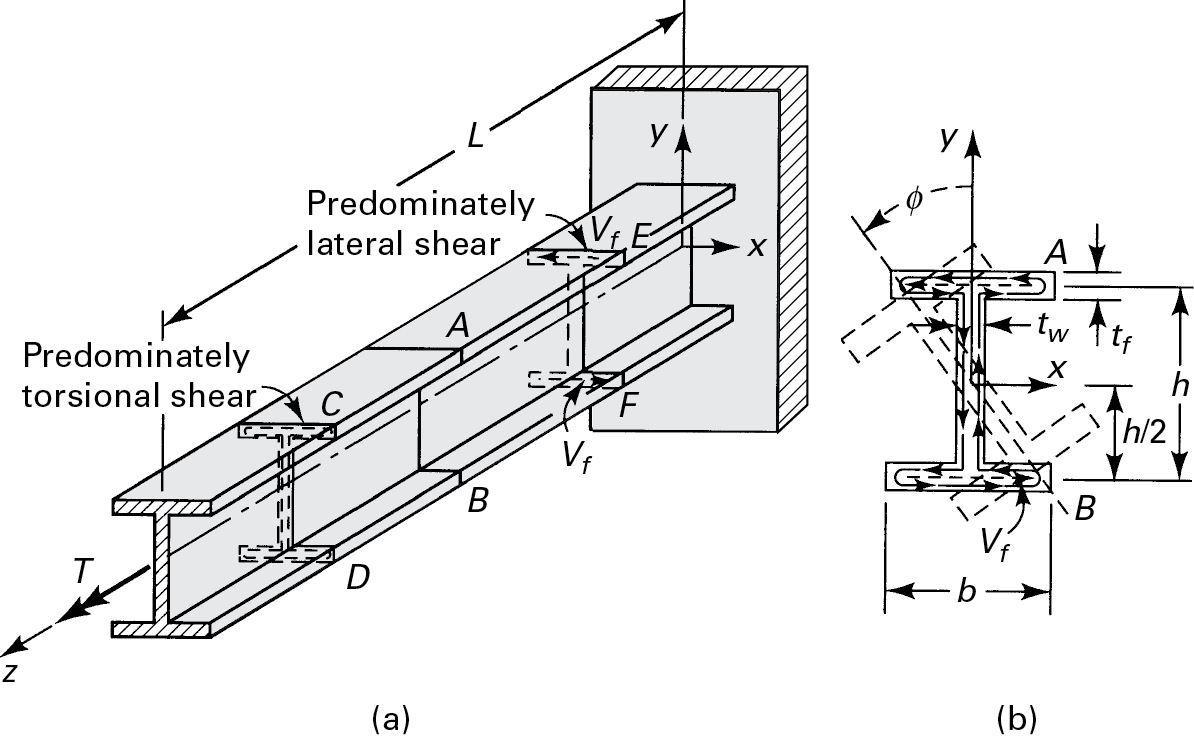
Figure 6.22. I-section torsion member: (a) warping is prevented for the section at x = 0; (b) partly lateral shear and partly torsional shear at arbitrary cross section AB.
6.10.1 Torsional and Lateral Shears
In Fig. 6.22a, the applied torque T is balanced in part by the action of torsional shearing stresses and in part by the resistance of the flanges to bending. At the representative section AB (Fig. 6.22b), consider the influence of torques T1 and T2. The former is attributable to pure torsional shearing stresses in the entire cross section, assumed to occur as though each cross section were free to warp. Torque T1 is thus related to the angle of twist of section AB by the expression
T1=Cdϕdz(a)
in which C is the torsional rigidity of the beam. The right-hand rule should be applied to furnish the sign convention for both torque and angle of twist. A pair of lateral shearing forces owing to bending of the flanges acting through the moment arm h gives rise to torque T2:
T2=Vfh(b)
An expression for vf may be derived by considering the x displacement, u. Because the beam cross section is symmetrical and the deformation is small, we have u = (hl2)ϕ, and
dudz=h2dϕdz(c)
Thus, the bending moment Mf and shear Vf in the flange are
Mf=EIfd2udz2=EIfh2d2ϕdz2(d)
Vf=−EIfd3udz3=EIfh2d3ϕdz3(e)
where If is the moment of inertia of one flange about the y axis. Now Eq. (b) becomes
T2=−EIfh22d3ϕdz3(f)
The total torque is then
T=T1+T2=Cdϕdz−EIfh22d3ϕdz3(6.27)
6.10.2 Boundary Conditions
The conditions appropriate to the flange ends are
(dϕdz)z=0=0, (d2ϕdz2)z=L=0
indicating that the slope and the bending moment are zero at the fixed and free ends, respectively. When these conditions are satisfied, the solution of Eq. (6.27) is
dϕdz=TC[1−coshα(L−z)coshαL](g)
where
α=(2CEIfh2)1/2(6.28)
6.10.3 Long Beams Under Torsion
For a beam of infinite length, Eq. (g) reduces to
dϕdz=TC(1−e−αz)(h)
By substituting Eq. (h) into Eqs. (a) and (f), we obtain the following expressions:
T1=T(1−e−αz)T2=Te−αz(6.29)
Thus, at the fixed end (z = 0), T1 = 0 and T2 = T. At this end, the applied torque is counterbalanced by the effect of shearing forces only, which from Eq. (b) are given by Vf = T2/h = T/h. The torque distribution, Eq. (6.29), indicates that sections such as EF, close to the fixed end, contain predominantly lateral shearing forces (Fig. 6.22a). Sections such as CD, near the free end, contain mainly torsional shearing stresses (as Eq. 6.29 indicates for z → ∞).
The flange bending moment, obtained from Eqs. (d) and (h), is at a maximum at z = 0:
Mf,max=EIfhα2CT(i)
The maximum bending moment, occurring at the fixed end of the flange, is found by substituting Eq. (6.28) into Eq. (i):
Mf,max=Tαh(6.30)
6.10.4 Angle of Twist
An expression for the angle of twist is determined by integrating Eq. (h) and satisfying the condition ϕ = 0 at z = 0:
ϕ=TC[z+1α(e−αz−1)](j)
For relatively long beams, for which e–αz may be neglected, the total angle of twist at the free end is, from Eq. (j),
ϕz=L=TC(L−1α)(6.31)
In this equation, the term 1/α indicates the influence of flange bending on the angle of twist. Since for pure torsion, the total angle of twist is given by ϕ = TL/C, it is clear that end restraint increases the stiffness of the beam in torsion.
Example 6.10 Analysis of an I-Beam Under Torsion
A cantilever I-beam with the idealized cross section shown in Fig. 6.22 is subjected to a torque of 1.2 kN · m. Determine (a) the maximum longitudinal stress and (b) the total angle of twist, ϕ. Take G = 80 GPa and E = 200 GPa. Let tf = 10 mm, tw = 7 mm, b = 0.1 m, h = 0.2 m, and 2.4 m.
Solution
The torsional rigidity of the beam is, from Eq. (6.21a),
C=Tθ=(b1t31+2b2t32)G3=(0.19×0.0073+2×0.1×0.013)G3 =8.839×10−8 G
The flexural rigidity of one flange is
IfE=0.01×0.1312E=8.333×10−7E
Hence, from Eq. (6.28) we have
1α=h√EIf2C=h√200×109×8333×10−78839×10−8×2=3.43h
From Eq. (6.30), the bending moment in the flange is found to be 3.43 times larger than the applied torque, T. Thus, the maximum longitudinal bending stress in the flange is
σf,max=Mf,maxXIf=3.43T×0.058333×10−7=0.2058×106T=247 MPa
Since e–αL = 0.03, we can apply Eq. (6.31) to calculate the angle of twist at the free end:
ϕ=TC(L−1α)=12008.839×10−8×80×109(2.4−3.43×0.2) =0.2908 rad
Comment If the ends of the beam were both free, the total angle of twist would be ϕ = TL/C = 0.4073 rad, and the beam would experience ϕfree/ϕfixed = 1.4 times more twist under the same torque.
6.11 Torsion Bar Springs
A torsion bar is a straight hollow or solid rod fixed at one end and twisted at the other, in which it is supported. It represents the simplest of all spring shapes, as depicted by the part AB in Figure 6.23a. Common applications of such members include counterbalancing for automobile hoods and trunk lids. Interestingly, a torsion bar with splined ends (Fig. 6.23b) is used for a vehicle suspension spring or sway bar. Often, one end fits into a socket on the chassis, and the other into the pivoted end of an arm. The arm is part of a linkage, permitting the wheel to rise and fall in approximately parallel motion. In a passenger car, the bar may have about ¾ m length, 25 mm diameter, and twist 30°–45°.

Figure 6.23. Torsion bar spring: (a) rod with bent ends; (b) rod with splined ends.
The stress in a torsion bar is basically that of torsional shear. Thus, the equations for torque, angular displacement, and stiffness, referring to Fig. (6.23a), are given as
T=PR δ=ϕR k=Tϕ
Here the angle of twist ϕ = TL/GJ. For the solid circular torsion bar, the moment of inertia is J = πd4/32. We thus have the formulas
τ=16PRπd3(6.32)
δ=TLRGJ=32PLR2πd4G(6.33)
k=πd4G32L(6.34)
where
τ = torsional shear stress
P = load
δ = relative displacement between ends
d = bar diameter
R = moment arm
L = bar length
k = spring rate
G = modulus of rigidity
These basic equations are supplemented, for torsion springs with noncircular cross sections, by Table 6.2. At the end parts of the spring that do not lie between supports A and B, there is a shear load P and an corresponding direct shear stress taking place on cross-sectional areas. Often, the effects of the curvature and of bending are neglected at these parts of the bar. When designing a torsion bar, the required diameter d is found by Eq. (6.32). On the basis of the allowable shear strength, then, Eq. (6.33) results in the bar length L necessary to provide the required deflection δ.
6.12 Curved Circular Bars
The assumptions of Section 6.2 are also valid for a curved, circular bar, provided that the radius r of the bar is small in comparison with the radius of curvature R. When r/R=112, for example, the maximum stress computed on the basis of the torsion formula, τ = Tr/J, is approximately 5% too low. In contrast, if the diameter of the bar is large relative to the radius of curvature, we must take the length differential of the longitudinal surface elements into consideration, and an area of stress concentration occurs at the inner point of the bar.
We are concerned here with the torsion of slender curved members for which r/R ≪ 1 Frequently, a curved bar is subjected to loads that at any cross section produce both a twisting moment and a bending moment. Expressions for the strain energy in torsion and bending have already been developed in this text (Sections 2.14 and 5.12), and application of Castigliano’s theorem (Section 10.4) leads readily to the displacements.
Consider the case of a cylindrical rod or bar bent into a quarter-circle of radius R, as shown in Fig. 6.24a. The rod is fixed at one end and loaded at the free end by a twisting moment T. The bending and twisting moments at any section are (Fig. 6.24b)
Mθ=Tsinθ, Tθ=−Tcosθ(a)
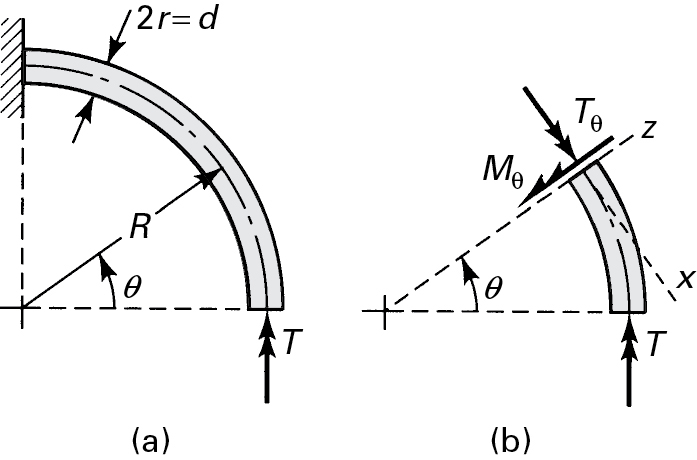
Figure 6.24. Twisting of a curved, circular bar.
Substituting these quantities into Eqs. (2.63) and (2.61), together with dx = ds = Rdθ, yields
U=12∫(M2θEI+T2θGJ)ds(b)
or
U=12T2R∫π/20(sin2θEI+cos2θGJ)dθ
where J = πd4/32 = 2I. The strain energy in the entire rod is obtained by integrating:
U=8(2+ν)Rd4ET2(6.35)
Upon application of ϕ = ∂U/∂T, it is found that
ϕ=16(2+ν)Rd4ET(6.36)
for the angle of twist at the free end.
6.12.1 Helical Springs
Springs are used to exert forces or torques in a mechanism or (mainly) to store the energy of impact load. A notable deflection is essential to most spring applications. These flexible members usually operate with high values for the ultimate stresses and with varying loads. Helical springs consist of round or rectangular wire, and flat springs (cantilever or simply supported beams) are widely used. Springs come in a number of other types, such as disk, ring, and torsion bar.
In the design of springs manufactured from curved bars or wires, deflection is as important as strength. Springs are employed to apply forces or torques in a mechanism or to absorb the energy owing to suddenly applied loads.*
*For an extensive discussion of springs, see Refs. 6.5 and 6.6.
A helical tension or compression spring provides a push or pull force and is capable of large deflection. The standard form (that is, the most common spring configuration) has constant coil diameter, pitch (axial distance between coils), and spring rate. Variable-pitch, barrel, and hourglass springs are used to minimize resonant surging and vibration.
Case Study 6.1 discusses a helical spring, produced by wrapping a wire around a cylinder in such a way that the wire forms a helix of uniformly spaced turns, as typifies a curved bar.
Case Study 6.1 Analysis of a Helical Spring
An open-coiled helical spring wound from wire of diameter d, with pitch angle α and N number of coils of radius R, is extended by an axial load P (Fig. 6.25). (a) Develop expressions for the maximum stress and deflection. (b) Redo part (a) for a closely coiled spring. (c) Find the spring rate for closely coiled spring.

Figure 6.25. Case Study 6.1. Helical spring under tension.
Assumption: Load is applied steadily at a rigid hook and loop at ends.
Solution An element of the spring located between two adjoining sections of the wire may be treated as a straight circular bar in torsion and bending. This is because a tangent to the coil at any point such as A is not perpendicular to the load. At cross section A, components P cos α and P sin α produce the following torque and moment:
T=PRcosα, M=PRsinα(c)
The stresses, from Eq. (4.7), are given by
σ1,2=16πd3(M±√M2+T2), τmax=16πd3√M2+T2
The maximum normal stress and the maximum shear stress are thus
σmax=16PRπd3(1+sinα)(6.37a)
τmax=16PRπd3(6.37b)
The deflection is computed by applying Castigliano’s theorem together with Eqs. (b) and (c):
δ=∫L0(PR2sin2αEI+PR2cos2αJG)ds
where the length of the coil L = 2πRN. It follows that the relationship
δ=2πPR3N(sin2αEI+cos2αJG)
or
δ=128PR3Nd4(sin2αE+cos2α2G)(6.38)
defines the axial end deflection of an open-coil helical spring.
For a closely coiled helical spring, the angle of pitch α of the coil is very small. The deflection is now produced entirely by the torsional stresses induced in the coil. To derive expressions for the stress and deflection, let α = sin α = 0 and cosα = 1 in Eqs. (6.37a) and (6.37b). In so doing, we obtain
τmax=σmax=16PRπd3(6.39)
δ=64PR3NGd4(6.40)
The elastic behavior of a spring may be expressed conveniently by the slope of its force–deflection curve or spring rate k. Through the use of Eq. 6.40, we obtain
k=Pδ=Gd464R3N(6.41)
Also known as the spring constant or spring scale, the spring rate has units of N/m in SI and lb/in. in the U.S. Customary System.
The standard helical spring has a spring rate k that is mainly linear over most of its operating range. The first and last few percent of its deflection have a nonlinear rate. Usually, in spring design, the spring rate is defined between approximately 15% and 85% of its total and working deflections.
Comment The approximate results obtained in this case study are applicable to both tension and compression helical springs, the wire diameters of which are small in relation to coil radius.
References
6.1. UGURAL, A. C. Mechanics of Materials Hoboken, NJ: Wiley, 2008.
6.2. TODHUNTER, I., and PEARSON, K. History of the Theory of Elasticity and the Strength of Materials, Vols. I and II. New York: Dover, 1960.
6.3. TIMOSHENKO, S. P., and GOODIER, J. N. Theory of Elasticity, 3rd ed. New York: McGraw-Hill, 1970.
6.4. YOUNG, W. C., BUDYNAS, R. G., and SADEGH, A. M. Roark’s Formulas for Stress and Strain, 8th ed. New York: McGraw-Hill, 2011.
6.5. UGURAL, A. C. Mechanical Design of Machine Components, 2nd ed. Boca Raton, FL: CRC Press, Taylor & Francis Group, 2016.
6.6. WAHL, A. M. Mechanical Springs. New York: McGraw-Hill, 1963.
Problems
Sections 6.1 through 6.3
6.1. A hollow steel shaft of outer radius c = 35 mm is fixed at one end and subjected to a torque T = 3 kN · m at the other end. Calculate the required inner radius b, knowing that the average shearing stress is limited to 100 MPa.
6.2. A solid shaft of 40-mm diameter is to be replaced by a hollow circular tube of the same material, resisting the same maximum shear stress and the same torque. Find the outer diameter D of the tube for the case in which its wall thickness is t = D/25.
6.3. A solid shaft of diameter d and a hollow shaft of outer diameter D = 60 mm and thickness t = D/4 are to transmit the same torque at the same maximum shear stress. What is the required diameter d the shaft?
6.4. Figure P6.4 shows four pulleys, attached to a solid stepped shaft, transmit the torques. Find the maximum shear stress for each shaft segment.
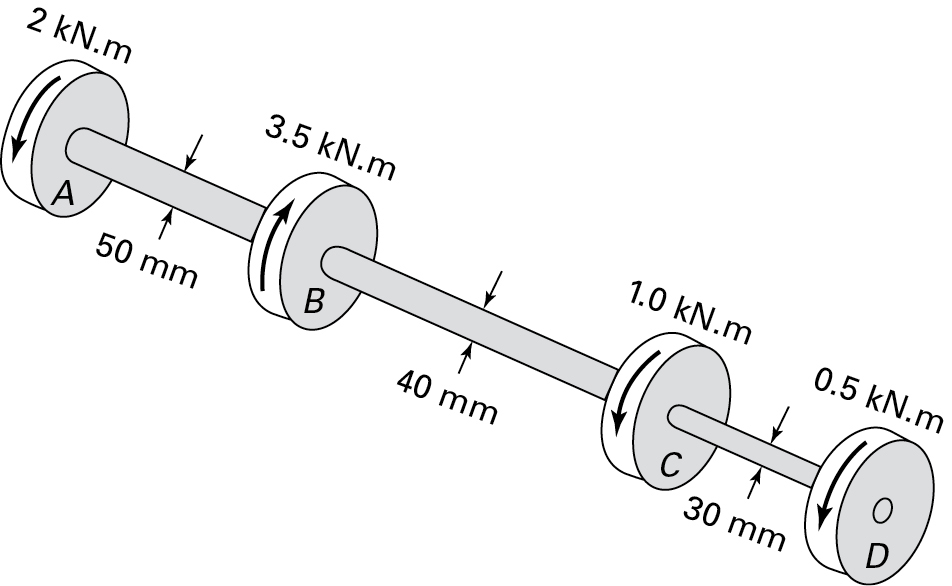
Figure P6.4.
6.5. Re-solve Prob. 6.4 for the case in which a hole of 16-mm diameter is drilled axially through the shaft to form a tube.
6.6. As seen in Fig. P6.6, a stepped shaft ABC with built-in end at A is subjected to the torques TB = 3 kN · m and Tc = 1 kN · m at sections B and C, respectively. Based on a stress concentration factor K = 1.6 at the step B, what is the maximum shearing stress in the shaft? Given: d1 = 50 mm and d2 = 40 mm.
6.7. A brass rod AB (Gb = 42 GPa) is bonded to an aluminum rod BC (Gd = 28 GPa), as illustrated in Fig. P6.6. Determine the angle of twist at C, for the case in which TB = 2Tc = 8 KN · m, d1 = 2d2 = 100 mm, and L1 = 2L2 = 0.7 m.
6.8. A hollow shaft is made by rolling a metal plate of thickness t into a cylindrical form and welding the edges along the helical seams oriented at an angle of ϕ to the axis of the member (Fig. P6.8). Calculate the maximum torque that can be applied to the shaft. Assumption: The allowable tensile and shear stresses in the weld are 120 MPa and 50 MPa, respectively. Given: D = 100 mm, t = 5 mm, and ϕ = 50°.
6.9. Re-solve Prob. 6.8 for the case in which the helical seam is oriented at an angle of ϕ = 35° to the axis of the member (Fig. P6.8).
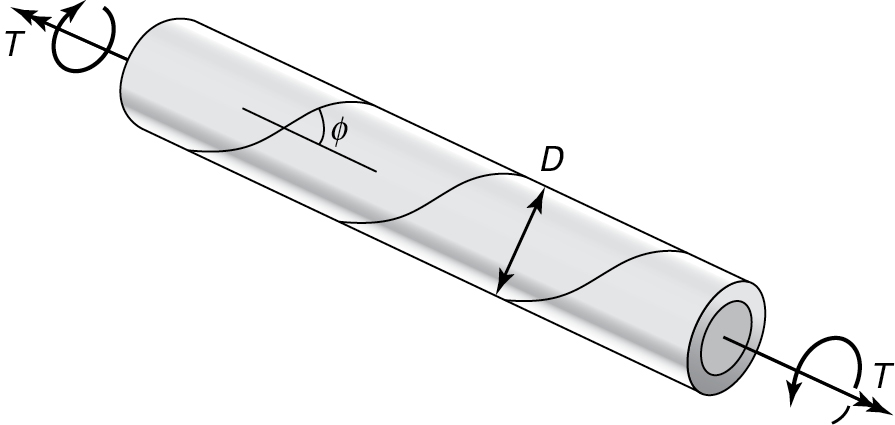
Figure P6.8.
6.10. What is the required diameter d1 for the segment AB of the shaft illustrated in Fig. P6.6 if the permissible shear stress is τall = 50 MPa and the total angle of twist between A and C is limited to ϕ = 0.02 rad? Given: G = 39 GPa, TB = 3 KN · m, Tc = 1 KN · m, L1 = 2 m, L2 = 1 m, and d2 = 25 mm.

Figure P6.6.
6.11. Re-solve Prob. 6.10 for the case in which the torque applied at B is TB = 2 KN · m and TC = 0.5 KN · m
6.12. A stepped shaft of diameters D and d is under a torque T, as shown in Fig. P6.12. The shaft has a fillet of radius r (see Fig. D.4). Determine (a) the maximum shear stress in the shaft for r = 1.0 mm and (b) the maximum shear stress in the shaft for r = 5 mm. Given: D = 60 mm, d = 50 mm, and T = 2 KN · m.

Figure P6.12.
6.13. Two steel shafts are connected by gears and carry a torque T (Fig. P6.13). Find: (a) The angle of rotation in degrees at D; (b) the maximum shearing stress in shaft AB. Given: G = 80 GPa, T = 600 N · m, d1 = 50 mm, d2 = 40 mm.

Figure P6.13.
6.14. A 33-kW motor, using a set of gears, drives a shaft at a speed n (Fig. P6.14). (a) Design, on the basis of a safety factor of 2.2, solid shafts AC and BC. (b) Calculate the total angle of twist between A and B. Given: G = 82 GPa, τyp = 210 MPa, n = 1500 rpm.
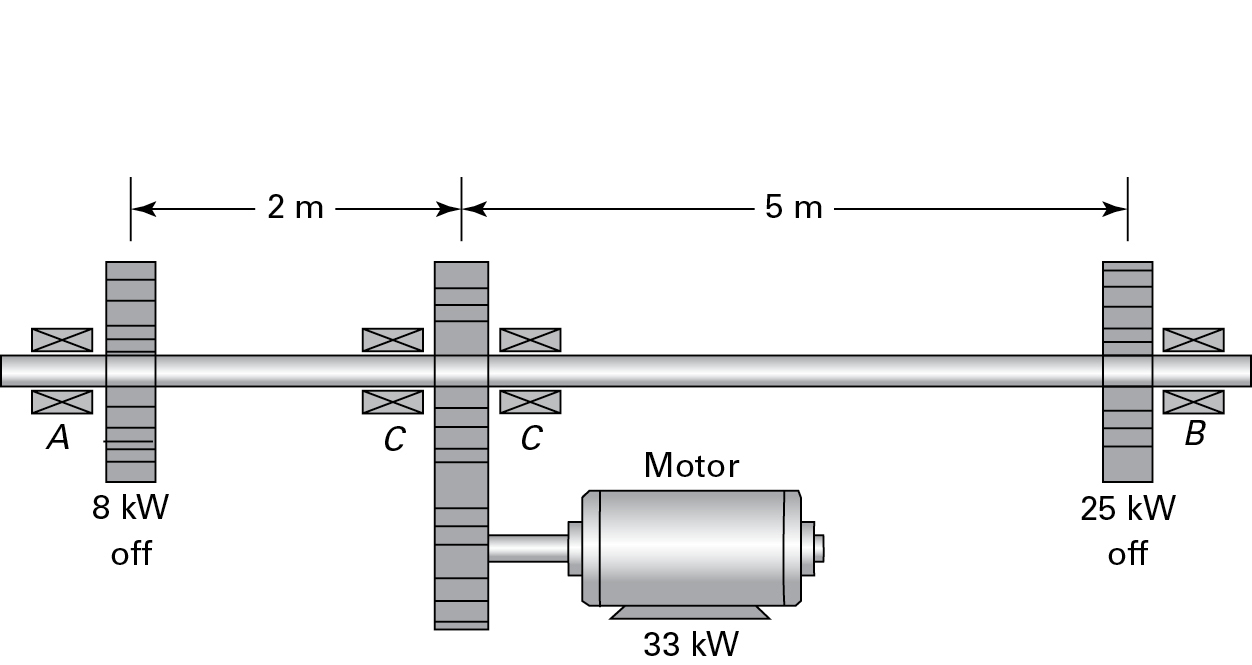
Figure P6.14.
6.15. A solid steel shaft of diameter D supports end loads P, M, and T. Find the factor of safety n, assuming that failure occurs according to the following criteria: (a) maximum shearing stress; (b) maximum energy of distortion. Given: τyp = 250 MPa, d = 80 mm, P = 40 kN, M = 4 kN · m, T = 8 kN · m.
6.16. Design a solid shaft for a 12-kW motor running at a speed n. Given: G = 80 GPa, τyp = 140 MPa, n = 3000 rpm. The angle of twist is not to exceed 1.8° per meter length. Assumptions: The shaft is made of steel. A factor of safety of 2.5 is used.
6.17. An outboard motor delivers 10 hp at 6000 rpm to the drive shaft of length L, as depicted in Fig. P6.17. The shaft is made of brass with modulus of elasticity G and an allowable shear stress τall. Find: (a) The required diameter d of the shaft; (b) the angle of twist ϕ of the shaft. Given: L = 0.6 m, G = 39 GPa, τ all = 70 MPa.

Figure P6.17.
6.18. A stepped shaft having solid circular parts with diameters D and d is in pure torsion (Fig. P6.12). The two parts are joined with a fillet of radius r (see Fig. D.4). If the shaft is made of brass with allowable shear strength 80 MPa, determine the largest torque capacity of the shaft. Given: D = 100 mm, d = 50 mm, r = 10 mm.
6.19. Consider two bars, one having a circular section of radius b, the other an elliptic section with semiaxes a, b (Fig. P6.19). (a) For equal angles of twist, which bar experiences the larger shearing stress? (b) For equal allowable shearing stresses, which bar resists a larger torque?

Figure P6.19.
6.20. A hollow (rj = b, r0 = c) and a solid (r0 = a) cylindrical shaft are constructed of the same material. The shafts are of identical length and cross-sectional area, and both are subjected to pure torsion. Find the ratio of the largest torques that may be applied to the shafts for c = 1.4b: (a) if the allowable stress is τa and (b) if the allowable angle of twist is θa.
6.21. A solid circular shaft AB, held rigidly at both ends, has two different diameters (Fig. 6.4a). For a maximum permissible shearing stress τall = 150 MPa, calculate the allowable torque T that may be applied at section C. Use da = 20 mm, db = 15 mm, and a = 2b = 0.4 m.
6.22. Re-solve Prob. 6.16 for τall = 70 MPa, da = 25 mm, db = 15 mm, and a = 1.6b = 0.8 m.
Sections 6.4 through 6.7
6.23. The stress function appropriate to a solid bar subjected to torques at its free ends is given by
where a and b are constants. Determine the value of k.
6.24. Figure P6.24 shows the cross section a × a of a cylinder resists a torque. Given: A stress function as follows:
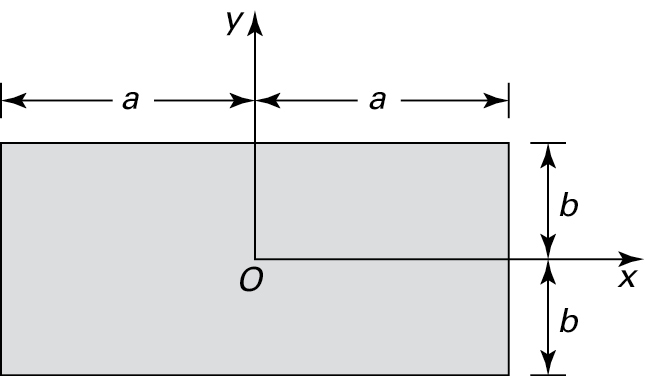
Figure P6.24.
in which k is a constant. Determine whether Eq. (P6.24) satisfies the required condition for a Prandtl’s stress function.
6.25. Show that Eqs. (6.6) through (6.11) are not altered by a shift of the origin of x, y, z from the center of twist to any point within the cross section defined by x = a and y = b, where a and b are constants. [Hint: The displacements are now expressed as u = −θz(y − b), υ = θz(x − a) and w = w(x, y).]
6.26. Rederive Eq. (6.11) for the case in which the stress function Φ = c on the boundary, where c is a nonzero constant.
6.27. A thin circular ring of cross-sectional radius r, shown in Fig. P6.27, is subjected to a distributed torque per unit length, Tθ = T cos2θ. Determine the angle of twist at sections A and B in terms of T, a, and r. Assume that the radius a is large enough to permit the effect of curvature on the torsion formula to be neglected.
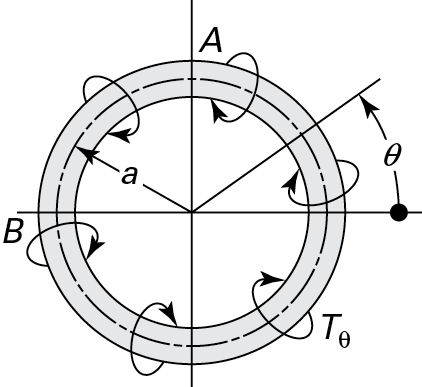
Figure P6.27.
6.28. Consider two bars of the same material: one circular of radius c, the other of rectangular section with dimensions a × 2a. Determine the radius c so that, for an applied torque, both the maximum shear stress and the angle of twist will not exceed the corresponding quantities in the rectangular bar.
6.29. The torsion solution for a cylinder of equilateral triangular section (Fig. 6.11) is derivable from the stress function, Eq. (j) of Section 6.5:
Derive expressions for the maximum and minimum shearing stresses and the twisting angle.
6.30. The torsional rigidity of a circle, an ellipse, and an equilateral triangle (Fig. 6.11) are denoted by CC, Ce, and Ct, respectively. If the cross-sectional areas of these sections are equal, demonstrate that the following relationships exist:
where a and b are the semiaxes of the ellipse in the x and y directions.
6.31. Two thin-walled circular tubes—one having a seamless section, the other (Fig. 6.17a) a split section—are subjected to the action of identical twisting moments. Both tubes have equal outer diameter do, inner diameter di, and thickness t. Determine the ratio of their angles of twist.
6.32. A steel bar of slender rectangular cross section (5 mm × 125 mm) is subjected to twisting moments of 80 N · m at the ends. Calculate the maximum shearing stress and the angle of twist per unit length. Take G = 80 GPa.
6.33. The torque T produces a rotation of 15° at the free end of the steel bar shown in Fig. P6.33. Use a = 24 mm, b = 16 mm, L = 400 m, and G = 80 GPa. What is the maximum shearing stress in the bar?
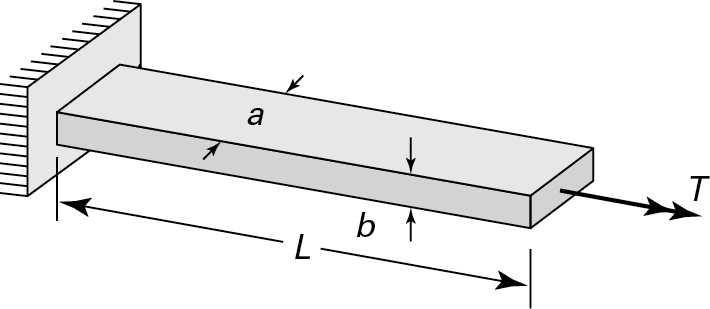
Figure P6.33.
6.34. Determine the largest permissible b×b square cross section of a steel shaft of length L = 3 m for which the shearing stress does not exceed 120 MPa and the shaft is twisted through 25° (Fig. P6.33). Take G = 75 GPa.
6.35. A steel bar (G = 200 GPa), whose cross section is shown in Fig. P6.35, is subjected to a torque of 500 N · m. Determine the maximum shearing stress and the angle of twist per unit length. The dimensions are b1 = 100 mm, b2 = 125 mm, t1 = 10 mm, andt2 = 4 mm.
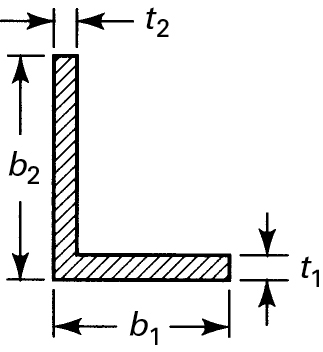
Figure P6.35.
6.36. Re-solve Example 6.7 for the case in which segments AC and CB of torsion member AB have as a cross section an equilateral triangular of sides a1 = 60 mm, and a2 = 45 mm, respectively.
6.37. Derive an approximate expression for the twisting moment in terms of G, θ, b, and to for the thin triangular section shown in Fig. P6.37. Assume that at any y the expression for the stress function Φ corresponds to a parabolic membrane appropriate to the width at that y: Φ = Gθ [(t/2)2 − x2].

Figure P6.37.
6.38. Consider the following sections: (a) a hollow tube of 50-mm outside diameter and 2.5-mm wall thickness; (b) an equal-leg angle, having the same perimeter and thickness as in (a); and (c) a square box section with 50-mm sides and 2.5-mm wall thickness. Compare the torsional rigidities and the maximum shearing stresses for the same applied torque.
6.39. The cross section of a 3-m-long steel bar is an equilateral triangle with 50-mm sides. The bar is subjected to end twisting couples, causing a maximum shearing stress equal to two-thirds of the elastic strength in shear (τyp = 420 MPa). Using Table 6.2, determine the angle of twist between the ends. Let G = 80 GPa.
Sections 6.8 through 6.12
6.40. Show that when Eq. (6.2) is applied to a thin-walled tube, it reduces to Eq. (6.22).
6.41. A torque T is applied to a thin-walled tube of a cross section in the form of a regular hexagon of constant wall thickness t and mean side length a. Derive relationships for the shearing stress τ and the angle of twist θ per unit length.
6.42. Re-solve Example 6.8 with a 0.01-m-thick vertical wall at the middle of the section.
6.43. The cross section of a thin-walled aluminum tube is an equilateral triangular section of mean side length 50 mm and wall thickness 3.5 mm. If the tube is subjected to a torque of 40 N · m, what are the maximum shearing stress and angle of twist per unit length? Let G = 28 GPa.
6.44. A square thin-walled tube of mean dimensions a × a and a circular thin-walled tube of mean radius c, both of the same material, length, thickness t, and cross-sectional area, are subjected to the same torque. Determine the ratios of the shearing stresses and the angle of twist of the tubes.
6.45. A hollow, multicell aluminum tube (cross section shown in Fig. P6.45) resists a torque of 4 kN · m. The wall thicknesses are t1 = t2 = t4 = t5 = 0.5 mm and t3 = 0.75 mm. Determine the maximum shearing stresses and the angle of twist per unit length. Let G = 28 GPa.

Figure P6.45.
6.46. A thin-walled tube of length L and constant wall thickness t with a multicell cross section resists a torque T (Fig. P6.46). Find the shearing stress and total angle of twist in terms of T, L, G, a, and t, as required.

Figure P6.46.
6.47. A steel torsion bar is used as a counterbalance spring for the trunk lid of a car (Fig. 6.24a). If one end of the bar rotates 75° relative to the other end, find (a) the change in torque and (b) the change in shearing stress. Given: L = 1.5 m, d = 10 mm, G = 79 GPa.
6.48. A steel torsion bar is subjected to a load of 2.4 kN with a moment arm R = 180 mm (Fig. 6.24a). Find: (a) The wire diameter; (b) the length for a deflection of 45 mm. Given: n = 2, τyp = 340 MPa, G = 79 GPa.
6.49. A high-strength steel torsion bar (G = 79 GPa) with splined ends (illustrated in Fig. 6.24b) has a length L = 1.1 m and a diameter d = 10 mm. Calculate, when relative rotation between the ends is changed by 15°, the torque and the shear stress.
6.50. Consider two closely coiled helical springs—one made of steel, the other of copper. Each spring is 0.01 m in wire diameter, and one fits within the other. Each has an identical number of coils, N = 20, and ends constrained to deflect the same amount. The steel outer spring has a diameter of 0.124 m, and the copper inner spring has a diameter of 0.1 m. Determine (a) the total axial load the two springs can jointly sustain if the shear stresses in the steel and the copper are not to exceed 500 and 300 MPa, respectively, and (b) the ratio of spring constants. For steel and copper, use shear moduli of elasticity Gs = 79 GPa and Gc = 41 GPa respectively.
